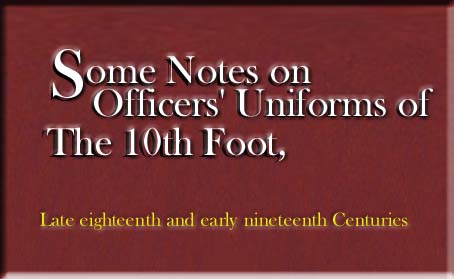

|
A study of the uniform of the 10th Foot at the end of the eighteenth and beginning of the nineteenth Centuries is virtually a study of the regulations which were in force at that time, as, unfortunately, very few items of dress or appointments have survived. Similarly, perhaps rather surprisingly, there seems to be very little contemporary pictorial information and the illustrations accompanying this article are based somewhat on conjecture and on what was worn by other regiments at the same time and in similar circumstances.
|
||
 |
The first illustration depicts an officer of a battalion
company of below Field Rank in Egypt. His headdress is the round hat
which appears to have been favoured by officers on tropical station.
As the regiment arrived direct from India, it is not unreasonable to
assume that this was worn, as paintings by Porter and De Loutherbourg,
as well as the contemporary set of watercolours by a member of the 61st
Foot depicting troops in Egypt all show this form of headdress. A black
cockade was worn on the left with silver regimental button and a cut
feather, white over red. In some regiments the hat was ornamented with
fur or feathers, and developed into a variety of shapes.
By this time officers of the Light Company would most likely be wearing the 'Stove Pipe' shako as authorised by the General Order 24th February 1800; this also applied to grenadiers, although they, as well as the battalion company officers, were allowed to retain the cocked hat. Grenadier officers appeared to be singularly well coiffed, as they still retained the bearskin cap. But, in the case of the 10th Foot, an inspection report dated 5th April 1804 stated, "No Grenadiers' or Drummers' Caps ..." The light and grenadier Companies were further distinguished by the wearing of a dark green and white plume respectively, and the grenadiers were ordered to wear a grenade badge in the centre of the cockade. The uniform coat was that prescribed in the Regulation of 1796, subsequently amended in 1797, and again in 1798, being of scarlet cloth faced with yellow The top buttons of the coat were normally left undone and the lapels turned back to reveal the yellow facings.The lapels were possibly edged with white as indicated in a portrait of an officer of the Tenth by Thomas Guest dated 1798 (but not clearly definable), and also in a portrait of a grenadier officer, 1801, in the collection of the late Percy Sumner. The buttonholes appear to be unlaced and certainly lace is not mentioned in several of the old tailors' pattern books of the period, or shown in Lawson's reconstruction of William Loftie's watercolour, executed at about the same time. |
|
|
The collar and cuffs were also yellow, and the silver buttons on the front of the coat, pockets, collar and cuffs had the number '10' within a ring, all in relief. The number of buttons on the lapel was normally nine or ten, including the one on the collar . At this time the buttons were evenly spaced but, by about 1805, seem to have changed to pairs. In accordance with regulation, grenadier and battalion company officers had cross pocket flaps, and light company, diagonal. Our illustration shows a single silver epaulette on yellow cloth on the right shoulder; grenadiers wore one on each shoulder which had an embroidered grenade on the strap; the light company had an embroidered bugle horn. The coat is lined with white kerseymere or shalloon, with the long skirts hooked back. The gorget was of the universal pattern of 1796, being gilt, with the King's cypher and crown engraved upon it. It was suspended by ribbons and rosettes in the facing colour, and the lower part was not to come below the fifth button of the lapel. |
||